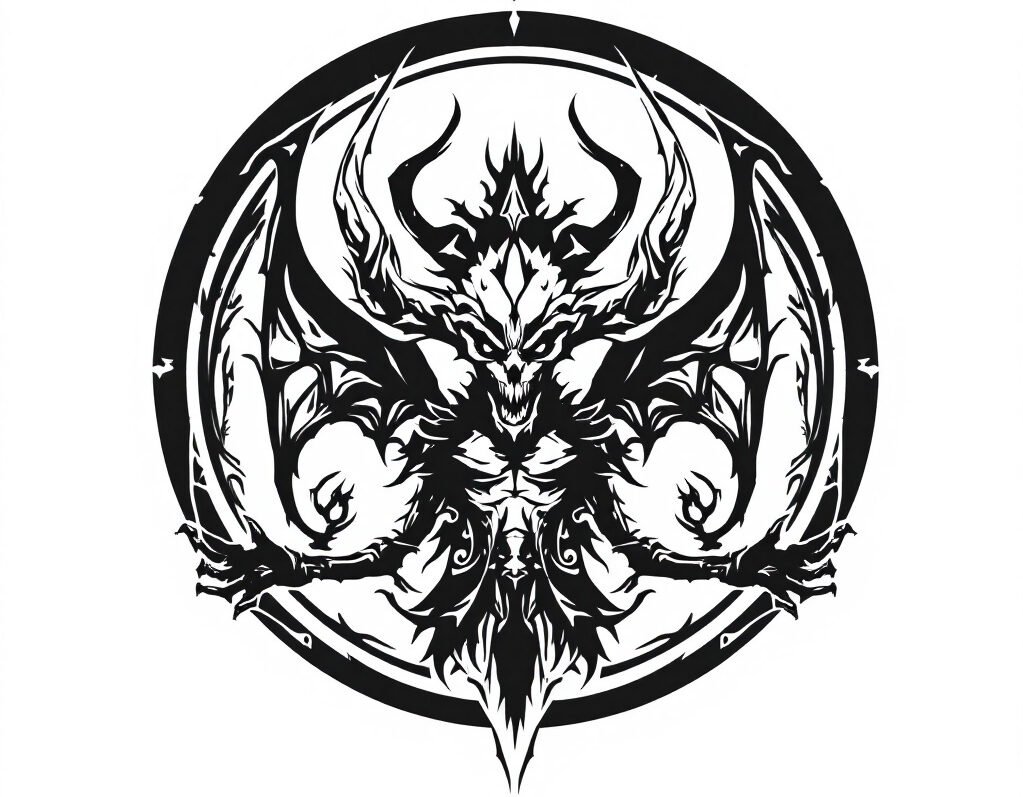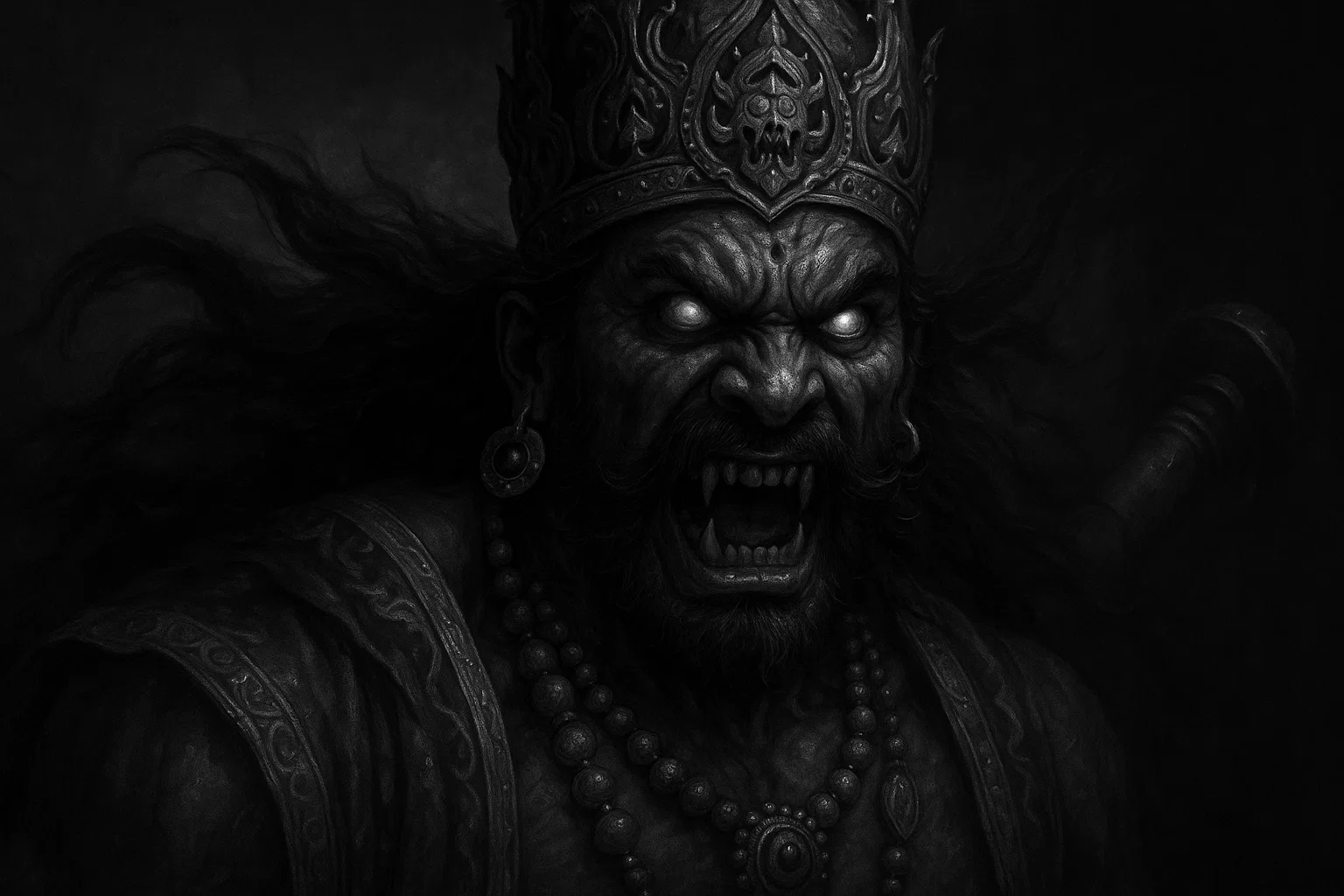Hiranyakashipu was a powerful king of the demons in ancient Indian stories. He ruled over many worlds and fought against the gods.
His story originates from Hindu sagas, where he attempted to become the most powerful being, but his own son turned against him due to faith in a higher god. This led to a major conflict that ultimately ended his rule. He is portrayed as the main villain in these myths, illustrating what happens when someone becomes too proud and mean.
Though he began as a brother seeking revenge for his lost family, Hiranyakashipu evolved into a ruler who harmed others and disregarded the principles of right and wrong. His end came from a clever trick by the god Vishnu, who took a special form to beat him.
Summary
Key Takeaways
| Attribute | Details |
|---|---|
| Names | Hiranyakashipu, Hiraṇyakaśipu |
| Title | King of the Asuras, Daitya Leader |
| Gender | Male |
| Role | Conqueror, tyrant, enemy of the gods; showed some heroic traits in battles but mostly harmful |
| Clan | Daitya |
| Followers | Asuras, Daityas, demons like Shakuni and Shambar |
| Powers | Near-invincibility from boons, mystic skills from hard practice, great fighting ability, rule over all beings |
| Appearance | Shown as a mighty demon with a mace, wearing gold items, crown, and jewelry; often in art as a strong king fighting a lion-man form |
| Etymology | Means “clothed in gold” or “one who likes wealth and comfort,” from Sanskrit words hiranya (gold) and kashipu (soft bed or cushion) |
| Associated Figures | Brother Hiranyaksha, son Prahlada, gods like Vishnu, Brahma, Shiva, Indra |
| Weaknesses | Killed by a half-man half-lion form that found holes in his protective boons |
| Opposing Deva/Avatar | Vishnu as Narasimha |
| Pantheon | Hindu, with roots in old texts |
| Primary Sources | Bhagavata Purana, Vishnu Purana, Shiva Purana, Vayu Purana, Mahabharata |
Hiranyakashipu Meaning
The name “Hiranyakashipu” likely originates from ancient Sanskrit words and holds profound significance in Hindu mythology.
Hiranyakashipu’s name is associated with ideas of wealth and ease. The first part, “hiranya,” translates to “gold,” referring to riches or shiny things. The second part, “kashipu,” points to a soft bed or cushion, showing comfort or a seat of power. Together, Hiranyakashipu’s definition is often seen as “one clothed in gold” or “a person who wants wealth and soft living.” This suits his role as a king who loved power and fine things, such as sitting on a golden throne during significant events.
The etymology of the name Hiranyakashipu can be found in texts like the Brahmanda Purana, where it is linked to a golden seat used in a fire ritual called atiratra. In that story, the name comes from the throne he sat near, making him seem like a ruler wrapped in gold. Some say it means “hair of gold,” but most agree it’s about his love for money and ease.
Across different books, the name changes slightly in how it’s pronounced or intended. The Bhagavata Purana highlights his greed and pride, which led to his fall. The Vishnu Purana uses it to show his strong rule over the worlds. In the Shiva Purana, it ties to his asking for power from the gods.
How To Pronounce Hiranyakashipu in English
Say it as “Hee-run-yuh-kuh-SHEE-poo.” Break it down: “Hee-run” for the first part, “yuh-kuh” in the middle, and “SHEE-poo” at the end. Stress the “SHEE” sound.
What Does Hiranyakashipu Look Like?
In Hindu art and stories, Hiranyakashipu appears as a formidable and intimidating demon king (Asura).
He is often depicted as a tall man with dark skin, wearing a crown and numerous pieces of gold jewelry. His clothes are rich and fancy, with red or gold cloth draped over him. He holds a big mace or club, his main weapon, ready to fight. His face looks angry, with wide eyes, sharp teeth, and sometimes a mustache or beard to show his fierce side.
Old paintings from the 18th century show him in battle with Narasimha, the lion-man form of Vishnu. There, he has a muscled body, standing tall but shocked as the god attacks. His arms might be raised in defense, and his hair could be wild. In some temple carvings from South India, he appears with extra arms to symbolize his power, as do many gods and demons in myths. But most times, he looks human-like, not too monster-ish, to stress his king status.
Texts like the Bhagavata Purana don’t provide much information about his looks, focusing more on his deeds. But from stories, he seems grand and scary, able to shake mountains.
In modern art or TV shows, he wears armor and has a proud stance. His golden items, such as rings and chains, highlight his affection for wealth and luxury.
Overall, his look warns of pride and power gone wrong.
Origins
Hiranyakashipu first appears in ancient Hindu texts (such as the Puranas), dating back to the early Common Era. He is part of a larger tale about gods and demons fighting for control.
His story begins in the Satya Yuga, the first age, where he is born as a demon but grows to rule everything through hard work and clever requests from the gods.
Over time, his tale grew in texts like the Bhagavata Purana and Vishnu Purana, becoming a key example of how pride leads to fall. In the early days, he might have been a simple villain, but later stories reveal his family ties and deep faith.
His role ties to cosmic balance, where demons like him test the gods. From a brother seeking payback to a tyrant killed by a god’s trick, his life covers birth, rise, rule, and end.
Birth
Hiranyakashipu was born to the wise man Kashyapa and his wife Diti, who was a daughter of Daksha. This happened in the Satya Yuga, the golden age. Diti and Kashyapa had children at dusk, an inauspicious time for such things, which led to their sons becoming demons. Hiranyakashipu and his brother Hiranyaksha came out strong and full of fight.
Stories say they were the gatekeepers of Vishnu, named Jaya and Vijaya, who, as four young, wise boys, were cursed by the Kumaras. The curse made them be born as demons three times to learn a lesson. In their first life, they became the brothers Hiranyakashipu and Hiranyaksha.
As a young demon, Hiranyakashipu learned fast and grew powerful. He saw his brother’s death by Vishnu’s boar form and got mad. This drove him to undergo severe penance to become strong enough for revenge.
Family
Hiranyakashipu had a big family with strong ties in the demon world. His parents were the wise Kashyapa, a great thinker, and Diti, from a line of creators. His brother Hiranyaksha was close to him, and his death sparked Hiranyakashipu‘s hate for Vishnu. He also had a sister named Holika (known for her fire-proof boon, but who died trying to hurt her nephew).
His wife was Kayadhu, a kind woman who stayed true during hard times. When the gods attacked their home while he was away, the wise Narada saved her and taught her unborn son about faith. This led to their son, Prahlada, becoming a devoted follower of Vishnu, causing conflict with his father. Hiranyakashipu had other sons, such as Anuhrada, Hlada, and Samhlada, who followed the ways of demons more closely.
Family played a key part in his story. His mom’s sadness over his brother’s death pushed him to power. His uncles and other kin helped in battles. However, the split with Prahlada demonstrated how faith can even sever close bonds.
| Genealogy | Details |
|---|---|
| Parents | Kashyapa (father), Diti (mother) |
| Siblings | Hiranyaksha (brother), Holika (sister) |
| Spouse | Kayadhu |
| Children | Prahlada, Anuhrada, Hlada, Samhlada |
Asura-Deva Conflicts
Hiranyakashipu played a significant role in the numerous conflicts between demons and gods in Hindu mythology. After getting his boons, he attacked the heavens and took Indra’s throne. He shook the Himalayas and ruled the three worlds, making gods run and hide.
His main fight was with Vishnu, who killed his brother in the form of a boar. Hiranyakashipu‘s rule broke dharma, the way of right, by hurting good people and stopping holy acts. Gods begged Vishnu for help, leading to the lion-man form that ended him. This clash maintained cosmic balance, ensuring that evil could not win forever.
These fights taught about duty and faith. Hiranyakashipu‘s pride hurt the world, but Prahlada’s trust brought back order.
You may also enjoy:
The Ghul: The Flesh-Eating Demon of Arabian Folklore
October 1, 2025
Ifrit: Demon of Fire Who Serves Iblis in Islamic Tradition
September 30, 2025
Agubanba: The Ash-Born Demon of Japanese Folklore
October 23, 2025
Who Is Abaddon, the Demon of the Abyss, in the Bible?
September 29, 2025
Mara: The Buddhist Demon King of Desire and Death
October 13, 2025
Mahakala: The Dark Guardian Who Consumes Evil
October 16, 2025
Role in Hindu Cosmology
Hiranyakashipu stands as a negative example in the broader context of Hindu worldviews. He shows what happens when someone breaks the cycle of right acts and rebirth by chasing endless power. As a villain, he tests the gods and pushes avatars like Narasimha to rectify the situation.
Though seen as a tyrant, he has some depth. His hard work in penance shows drive, but twisted by hate. This ties to the idea of dharma, where the wrong use of power leads to downfall. He affects both human and divine affairs by ruling harshly, but his son’s faith shows that good can come from bad.
In the end, his death brings balance, showing rebirth and cosmic order win over pride.
Was Hiranyakashipu Ever Mentioned in Vedic Texts?
Hiranyakashipu does not appear in the Rig Veda, Atharva Veda, or other ancient Vedic texts. He likely started in later epics and Puranas, where stories grew around gods and demons. Vedic hymns focus on nature gods and rituals, rather than detailed descriptions of demon kings like him.
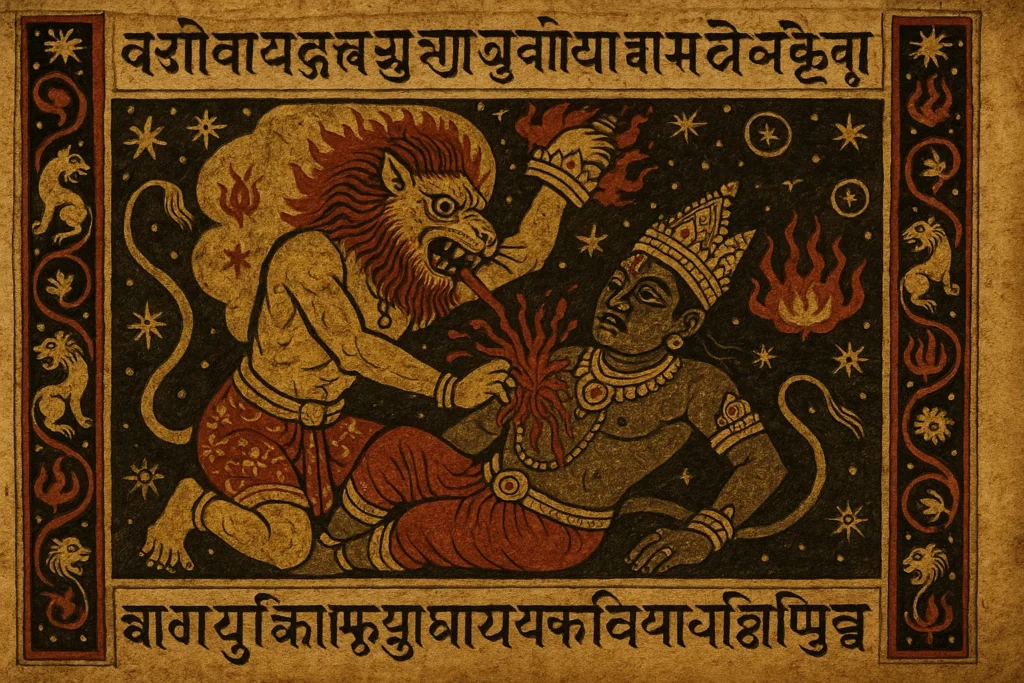
Hiranyakashipu in Epics and Puranas
Hiranyakashipu is mentioned in various texts, including the Bhagavata Purana, a work attributed to unknown authors, where he is the main villain in Canto 7.
Valmiki’s Ramayana mentions him in passing as a strong demon. In the Mahabharata’s Anushasana Parva, Vyasa tells of his penance to Shiva. The Vishnu Purana details his birth and death.
| Source | Quote |
|---|---|
| Bhagavata Purana 7.3.35–38 | O my lord, O best of the givers of benediction, if you will kindly grant me the benediction I desire, please let me not meet death from any of the living entities created by you. Grant me that I not die within any residence or outside any residence, during the daytime or at night, nor on the ground or in the sky. Grant me that my death not be brought by any being created by you, nor by any weapon, nor by any human being or animal. Grant me that I not meet the death from any entity, living or nonliving. Grant me, further, that I not be killed by any demigod or demon or by any great snake from the lower planets. Since no one can kill you in the battlefield, you have no competitor. Therefore, grant me the benediction that I too may have no rival. Give me sole lordship over all the living entities and presiding deities, and give me all the glories obtained by that position. Furthermore, give me all the mystic powers attained by long austerities and the practice of yoga, for these cannot be lost at any time. |
| Bhagavata Purana 7.7.6 | The victorious demigods plundered the palace of Hiranyakasipu, the King of the demons, and destroyed everything within it. Then Indra, King of heaven, arrested my mother, the Queen. |
| Bhagavata Purana 7.7.8 | Narada Muni said: O Indra, King of the demigods, this woman is certainly sinless. You should not drag her off in this merciless way. O greatly fortunate one, this chaste woman is the wife of another. You must immediately release her. |
| Bhagavata Purana 7.8.12 | O most unfortunate Prahlada, you have always described a supreme being other than me, a supreme being who is above everything, who is the controller of everyone, and who is all-pervading. But where is He? If He is everywhere, then why is He not present before me in this pillar? |
| Bhagavata Purana 7.8.29 | Lord Nrisimhadeva placed the demon on His lap, supporting him with His thighs, and in the doorway of the assembly hall the Lord very easily tore the demon to pieces with the nails of His hand. |
| Mahabharata Anushasana Parva, section 14 | Hiranyakashipu also performed tapas to propitiate Shiva. Shiva granted Hiranyakashipu the boon that he would have unrivalled combat prowess, exceeding skill in the use of bow and other weapons, as well as the powers of all the gods, including Indra, Yama, Kubera, Surya, Agni, Vayu, Soma, and Varuna. |
Powers and Abilities
Hiranyakashipu is typically portraited as a powerful Asura. His powers include:
- Near-invincibility: Could not be killed by most beings, weapons, or, in certain places and times, by boons by Brahma.
- Mystic skills: Gained through long, hard practice and yoga, allowing him to control his mind and body.
- Combat strength: Great skill with bow and weapons, plus powers of gods like Indra and Agni, from Shiva’s boon.
- Rule over all: Lordship over living things and gods, with no rivals.
- Shake mountains: So strong he could move the Himalayas.
- Long rule: Held power for over 107 million years.
- Shape change: Some tales say he could change form.
- Conquer worlds: Took over heavens, earth, and below.
Hiranyakashipu Myths, Legends, and Stories
Penance and Boon from Brahma
After his brother Hiranyaksha was killed by Vishnu in the form of a boar, Hiranyakashipu felt great anger. He chose to earn magical strength by performing rigorous worship to Brahma. He went to a hill and stood on his toes, arms up, staring at the sky. He ate no food, drank no water, and held his breath for years. His body got thin, but his will stayed firm. The heat from his worship made the world hot, and rivers dried up. Gods got scared and asked Brahma to act.
Brahma came on his swan ride and sprinkled water on Hiranyakashipu to bring back his body. He praised the demon’s hard work and offered a gift in return. Hiranyakashipu asked for endless life, but Brahma said no god can give that. So, Hiranyakashipu asked for safety from death in clever ways: not from any made being, not inside or outside, not day or night, not on the ground or in the sky, not by man or beast, not by weapon or living thing.
Brahma gave the gift, saying it was hard but true. Hiranyakashipu felt unbeatable and thanked Brahma. With this strength, he set out to rule everything.
Conquest of the Three Worlds
With his new strength, Hiranyakashipu gathered his demon army and attacked the gods. He stormed the heavens, beat Indra, and took his seat. Eventually, the gods fled in fear.
He ruled the three worlds: sky, earth, and below. He made people worship him as a god and stopped holy acts. His power was so great that he shook the big mountains to their base. Even strong ones like Ravana could not lift his heavy earrings.
According to the Skanda Purana, Hiranyakashipu ruled for over 107 million years. Demons grew strong under him, and gods hid. He lived in luxury, but his pride made him cruel. This time showed his might but also set up his fall.
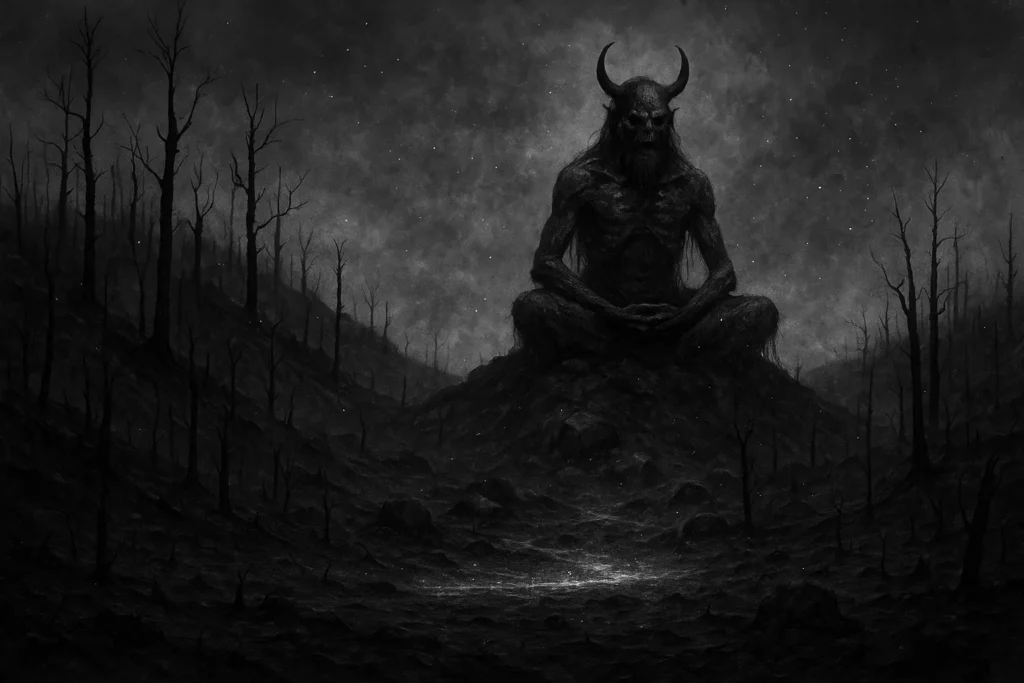
Attack on Kayadhu
While Hiranyakashipu was spending time in rigorous worship to gain power and immortality, a calamity struck his realm. The mighty Indra, king of the gods, with a small battalion of celestial beings, launched a surprise attack on Hiranyakashipu’s opulent palace, seeking to reclaim the treasures and dignity that the demon king had unjustly seized. In the chaos that followed, they captured Kayadhu, Hiranyakashipu’s devoted wife, who was with child.
Indra intended to detain her until the child was born; if it turned out to be a boy, he would eliminate the infant, fearing it could grow into a rival to the celestial order. However, the astute sage Narada intervened at that critical moment. With his profound wisdom, he discerned the purity of Kayadhu’s heart and the potential goodness of the unborn child. He advised Indra to reconsider, emphasizing that her soul was destined for greatness.
Recognizing the futility of Indra’s plan, Narada graciously took Kayadhu under his protection, bringing her to his hermitage, a tranquil retreat. There, he nurtured her and imparted to her the timeless wisdom of devotion and faith in Lord Vishnu, the preserver of the universe. During this period of instruction, the unborn child in Kayadhu’s womb absorbed these sacred teachings, allowing them to resonate deeply within him.
When Hiranyakashipu eventually returned, he was met with the joyous news that Kayadhu had given birth to a son named Prahlada. Unbeknownst to his father, the sacred lessons instilled in him by Narada had taken root, and Prahlada grew into a remarkable child, radiating an unwavering love and devotion to Vishnu, despite the ominous legacy of his lineage. Thus, the seeds of loyalty and righteousness were sown in the heart of Prahlada, setting the stage for an epic confrontation between devotion and tyranny.
Attempts to Kill Prahlada
Hiranyakashipu, the powerful demon king, was consumed by rage when he discovered that his own son, Prahlada, fervently praised Lord Vishnu instead of acknowledging his father’s authority.
In an attempt to corrupt Prahlada’s devotion, Hiranyakashipu sent him to various demon teachers, hoping they would instill in him the ways of their malevolent kind. However, instead of learning the dark arts, Prahlada used his time to share the teachings of Vishnu, further angering his father.
Frustrated by his son’s unwavering devotion, Hiranyakashipu launched a series of violent attempts to rid himself of Prahlada. He hurled his son off towering cliffs, yet the gentle winds miraculously lifted Prahlada back to safety. He commanded massive elephants to trample the young boy, but surprisingly, the animals refused to lay a paw on him. When venomous snakes sank their fangs into Prahlada, he remained unharmed, as if shielded by an invisible force. Even when raging flames surrounded him, he emerged untouched, his spirit unbroken and cool in the heat.
The king’s despair reached new heights when he devised a sinister plan involving his sister Holika, who possessed a divine boon protecting her from fire. He made Prahlada sit beside Holika in a blazing pyre, believing that she would remain unscathed while his son perished.
However, the deeply rooted devotion of Prahlada proved stronger. The flames danced around him, but they engulfed Holika instead, leading to her tragic demise.
This miraculous escape and Holika’s fate gave rise to the joyous festival of Holi, which celebrates the triumph of devotion and love over evil. Each of Hiranyakashipu’s attempts culminated in failure, as Vishnu’s divine protection stood firmly guard over Prahlada.
You may also enjoy:
Abura-akago: The Oil-Licking Demon Baby
October 22, 2025
Who Is Agares, the Demon of Earthquakes and Deception?
October 13, 2025
Aamon: The Infernal Marquis of Lust, Feuds, and False Prophecies
September 29, 2025
Arati: The Beautiful Demon of Aversion in Buddhist Mythology
October 15, 2025
Who Was Hiranyaksha, the Golden-Eyed Asura?
October 7, 2025
Vaisravana: The Golden Guardian King Who Rules the North
October 16, 2025
Hiranyakashipu’s Death
In the final confrontation, Hiranyakashipu proposed his son, Prahlada, with one last challenge, questioning the very existence of Lord Vishnu. “If Vishnu truly pervades all existence, then where is he?” he demanded with a derisive laugh. Undaunted, Prahlada boldly replied, “He resides even within the pillars of this hall.”
With mistrust, Hiranyakashipu raised his mace and struck the pillar with unrestrained force. To his astonishment and the utter shock of those present, the pillar erupted, and from its depths emerged Narasimha, the fierce avatar of Vishnu—part man, part lion—his savage roar reverberating through the air and sending shivers down the spines of all who heard it.
In a swift and terrifying motion, Narasimha seized Hiranyakashipu as dusk fell, the dim light casting eerie shadows across the scene. He placed the demon king in his lap—a symbol of ultimate defeat—and with a ferocious growl, he raked his lethal claws through Hiranyakashipu’s body.
In that crucial moment, the conditions of all Hiranyakashipu’s invincible boons were rendered meaningless; Narasimha struck not in the light of day nor the shadows of night, neither indoors nor outdoors, neither on the earth nor in the sky, and he was neither man nor beast. This divine retribution was executed without the use of a traditional weapon, showcasing the omnipotence of the sacred.
The heavens erupted with cheers from the assembled gods as cosmic balance was restored, celebrating the end of Hiranyakashipu’s reign of terror.
Hiranyakashipu vs Other Asuras
| Asura Name | Associated Trait/Role | Clan/Origin | Key Traits/Powers |
|---|---|---|---|
| Ravana | Conquest, abduction | Rakshasa, Ramayana | Ten heads, boons from Brahma, shape-shifting, great scholar |
| Mahishasura | Buffalo demon, war with gods | Asura, Puranas | Shape-changing, defeated by Durga, super strength |
| Bali | Generous king, conqueror | Daitya, Puranas | Boon of strength, devotion, tricked by Vamana |
| Vritra | Drought causer, blocker of waters | Danava, Vedas | Huge serpent form, control over rain, killed by Indra |
| Narakasura | Kidnapper of women | Asura, Puranas | Ruler of Pragjyotisha, boons, killed by Krishna |
| Banasura | Thousand-armed warrior | Asura, Puranas | Thousand arms, ally of Shiva, fought Krishna |
| Hiranyaksha | Earth submerger | Daitya, Puranas | Sank earth into ocean, super strength, killed by Varaha |
| Andhaka | Blind demon, attacker of gods | Asura, Puranas | Born from Shiva’s sweat, thousand heads and arms, regeneration |
| Tarakasura | Invincible to most, war leader | Asura, Puranas | Boon only Shiva’s son could kill him, great power |
| Shumbha | Leader in war with Durga | Daitya, Puranas | Shape-shifting, army command, killed by Durga |
| Nishumbha | Brother and co-ruler | Daitya, Puranas | Great fighter, boons, slain by Durga |
| Madhu | Honey demon, destroyer | Daitya, Puranas | Boon no weapon could kill, slain by Vishnu |
| Kaitabha | Twin demon, chaos creator | Daitya, Puranas | Born from Vishnu’s ear, super strength, killed by Vishnu |
| Raktabija | Blood seed, multiplier | Asura, Puranas | Every blood drop makes clone, killed by Kali |
| Kalanemi | Time wheel, deceiver | Asura, Puranas | Illusion powers, fought Vishnu, reincarnation |
Rank Among Asuras
Hiranyakashipu held a high spot as a leader in the Daitya clan, one of the main demon groups. As king, he ruled over many Asuras and led them against the gods. He stood above others like his brother Hiranyaksha, who sank the earth but was killed first.
In clans, Daityas like him and Bali focused on power through worship. He had ties with uncles and kin who helped in wars. But rivalries with gods like Indra marked him.
Among Asuras, he was top for his smart boons and long rule, but his pride split him from even his son.
His rank revealed Daitya’s strength but also its flaws. He led well but fell hard, unlike some, like Bali, who had good sides.
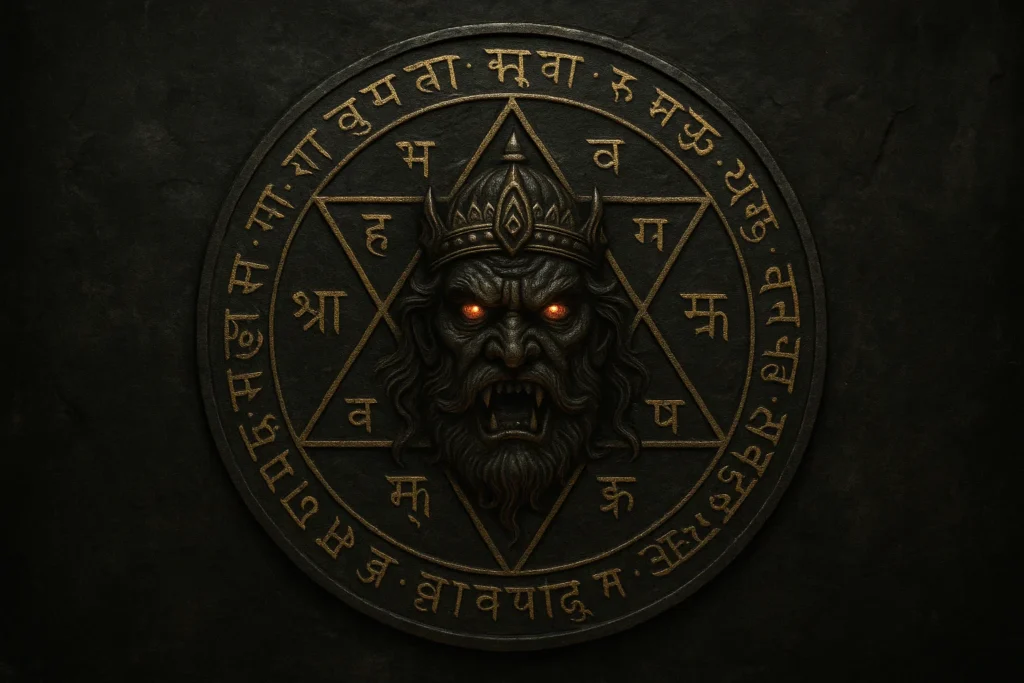
Mystical Correspondences
| Attribute | Details |
|---|---|
| Planet | Saturn |
| Zodiac Sign | Capricorn |
| Element | Earth |
| Direction | West |
| Color | Black |
| Number | 8 |
| Crystal/Mineral | Onyx |
| Metal | Iron |
| Herb/Plant | Myrrh |
| Animal | Buffalo |
| Trait/Role | Arrogance, conquest |
Hiranyakashipu‘s ties to the stars show his hard and ruling nature. Saturn, his planet, stands for limits and tough lessons, much like his long worship and strict rule. This planet demands hard work but warns against the dangers of pride. Rituals for him might happen on Saturdays, when Saturn’s pull is strong, to call his strength in fights.
His sign, Capricorn, brings drive and ambition to climb to power, like his rise to rule the world. This earth sign fits his ground-shaking might and want for lasting thrones.
From stars to earth, his element is earth, showing solid power and ties to wealth like gold in his name. Earth gives us strength, but it can also entrap us in worldly desires. West, his direction, links to ends and dark, fitting his fall at dusk.
Black, his color, means mystery and fear, like his scary rule. Number 8 ties to endless loops, such as his request for no death. Onyx crystal shields but holds dark energy. Iron metal shows its hard will. Myrrh is a cleansing herb that has a scent reminiscent of death rites. A buffalo animal symbolizes raw strength and ferocity, much like its powerful attacks.
Hiranyakashipu’s Symbols
Hiranyakashipu‘s main symbols include his mace, a heavy club used for battle, which showcases his raw power. The golden throne symbolizes his love of wealth and power. In art, broken pillars represent the spot where Narasimha is said to have emerged.
Worship and Boons
Hiranyakashipu undertook a prolonged and arduous period of tapasya, standing on his toes for many years while abstaining from food and water. His sole purpose was to appease Brahma, the creator god, in hopes of attaining immense powers. This grueling penance drained his physical strength but fortified his mental resolve, making him a formidable force.
The intensity of his penance generated a fearsome aura so potent that it alarmed the gods themselves.
In response to his relentless devotion, Brahma appeared before Hiranyakashipu and granted him several formidable boons. Among these were the assurances that he would not face death at the hands of any living being, whether created by divine or earthly realms, and that he would remain invulnerable during the day or night, on the ground or in the sky, whether confronted by a man or a beast, and rendered impervious to all forms of weaponry.
Additionally, Hiranyakashipu undertook further penance dedicated to Lord Shiva, which endowed him with unparalleled combat skills and divine powers. He acquired the ability to wield Indra’s thunder and command Agni’s fire, which contributed significantly to his supremacy and dominance over the cosmos.
You may also enjoy:
Abura-akago: The Oil-Licking Demon Baby
October 22, 2025
Who Is Adrammelech in Demonology and the Bible?
October 1, 2025
Who Was Abezethibou, the Fallen Angel Who Opposed Moses?
October 1, 2025
Vritra: The Dragon Who Swallowed the Sky in Hindu Mythology
October 7, 2025
The Ghul: The Flesh-Eating Demon of Arabian Folklore
October 1, 2025
Who Was Hiranyakashipu, the Demon King of Hindu Mythology?
October 6, 2025
